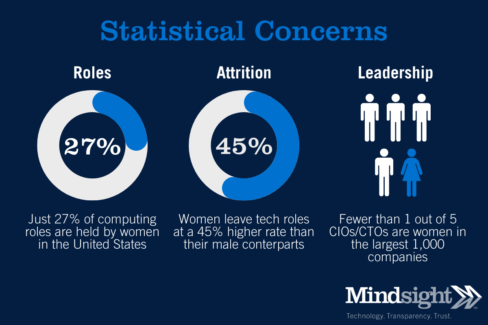October 13, 2022
At a time when the tech sector needs qualified talent more than ever, women comprise only about a quarter of the data, AI and cybersecurity workforce. There’s even a huge gap in startup funding for women. Mindsight first reported this discrepancy in July of 2021. Has anything changed since?
Sadly, not much has changed. Their rate of attrition is dismal, as well. “Even when women are trained or re-trained with in-demand IT skill sets,” a recent CIO.com article notes, “many opt to leave the field early in their careers, discouraged by the obstacles or disillusioned that they still aren’t seeing ample female representation in technology leadership roles.”
That’s not surprising. According to a recent Navisite survey, women in tech are held to a higher standard than their male counterparts. Not only that, a VentureBeat write-up explains, they’re “being asked to perform the bulk of administrative tasks…. Additionally, 86% of women say they’ve been accused of being too emotional or are described with similarly gender-charged words in the workplace.”
What Can Be Done?
Change is needed—and outside-the-box thinking is necessary to get there.
Mentoring by women in positions of influence helps, but it goes only so far because the tech sector is and long has been male dominated. “In spite of the efforts made encouraging girls and women to pursue technology careers, the gender imbalance is greater than it was 35 years ago,” a recent Accenture report reveals.
The “regression,” Accenture’s report goes on, is largely since college and professional cultures are insufficiently inclusive. Progress in tech is heavily reliant on “the environments in which girls and women study, and then work.” Those environments, unfortunately, remain less-than-friendly.
Consider the following shortfalls:
- Just 16% of engineering roles and only 27% of computing roles are held by women in the US.
- Fewer than 1 out of 5 CIOs or CTOs are women in the largest 1,000 companies.
- Women leave tech roles at a 45% higher rate than men.

Events like the annual Women in Tech Summit and WomenTech Global Conference are making headway toward solving the gender imbalance. But while women can help other women overcome barriers and realize their value in tech, insiders say, it takes even more than that. It takes a culture-wide mindset shift. “It’s all about day-to-day nudging, managing, and influencing our own people in our organizations,” Vipin Gupta, chief innovation and digital officer at Toyota Financial Services, told CIO.com. His efforts in striving for gender equality involve “early-stage awareness of STEM careers, promotion of female tech leadership and internal upskilling.”
From Bad to Worse
For women of color in tech, things are even worse. A study from the Kapor Center’s Women of Color in Computing Collaborative “found robust evidence of bias, which was associated with women of color in tech being the equivalent of 37.6 percentage points less likely than white women to see a long-term future for themselves at their companies,” wrote the study’s lead researcher, Joan C. Williams, Distinguished Professor of Law and Director of the Center for Work Life Law at University of California Hastings Law. “Women of color in tech were also 16.4 percentage points more likely than white women to report that they have left or considered leaving a company because of its culture.”
The bottom line, Williams added in her study synopsis, is that “tech is less of a meritocracy than we like to think. Women of color were dramatically more likely than white women to report bias in hiring, assignments, promotions and compensation, performance evaluations and access to sponsorship network.”

Effect of the COVID-19 Pandemic
According to a Kaspersky survey, COVID was another significant blow for women in tech. Half of those surveyed, it reveals, believe the pandemic “delayed, rather than enhanced, their career progression. Some of the main reasons around this come down to day-to-day functions such as home-schooling and cleaning being a major part but other issues such as adapting working hours around family life also play a huge part.”
There’s no “silver bullet” solution, however. And though hiring more women helps, it’s also about retaining them. “We can recruit and recruit all we want, but retention is a critical piece,” Lynn Dohn, executive director of WiCyS, told CIO. “It’s death by 1,000 paper cuts,” she said of the many factors that cause women to leave, among them unconscious bias and lack of promotions. “A lot of people focus on the metrics of diversity, but when you really look at it, inclusion is that sense of belonging, that trust in wanting to work at a place. That’s the real issue.”
Bridging the Gap
In TrustRadius’s most recent Women in Tech Report, responses from more than 450 tech professionals (66% who identified as women) covers the many challenges (many of them mentioned in this post) that women in tech continue to face. It also contains suggestions for how to fix them, including:
- A more flexible work model that allows for a better balance between career and family
- Training all tech colleagues to recognize unconscious bias
- Prioritize equal/transparent pay and parental leave
- Provide more mentorship programs
There’s evidence that those things and other methods are working. In leadership roles, especially, the percentage of women has risen nearly 7 percent since 2019, according to Deloitte Global. Also, per Deloitte research, overall female representation in large global tech firms hovers around 33 percent—up roughly two percent from 2019. That’s partly because firms inside and outside of tech are more seriously focusing on diversifying their workforces. Consequently, many tech leaders—including a number of influential women—are heartened by what they’re seeing. But there remains plenty of room for improvement.
“When all is said and done, improving women’s representation in technology calls for the same kind of leadership commitment and strategic focus that underlies other critical organizational initiatives,” reads an essay co-authored by four women in tech leadership roles at Deloitte. “Companies should identify a responsible executive and commit to a holistic diversity, equity, and inclusion strategy that cultivates an inclusive culture. Accountability and transparency—identifying metrics, reporting results, and tracking progress—are essential. Only then can companies take stock of what is and isn’t working, revise their approach, and improve.”
About Mindsight
Mindsight, a Chicago IT services provider, is an extension of your team. Our culture is built on transparency and trust, and our team is made up of extraordinary people – the kinds of people you would hire. We have one of the largest expert-level engineering teams delivering the full spectrum of IT services and solutions, from cloud to infrastructure, collaboration to contact center. Our customers rely on our thought leadership, responsiveness, and dedication to solving their toughest technology challenges.
Contact us at GoMindsight.com.
